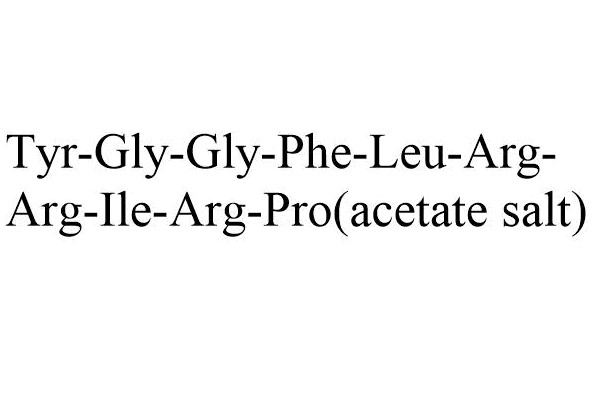keep away from moisture
Powder: -20°C for 3 years | In solvent: -80°C for 1 year

Dynorphin A (1-10) acetate is an endogenous opioid neuropeptide, binds to extracellular loop 2 of the κ-opioid receptor. Dynorphin A (1-10) also blocks NMDA-activated current with an IC50 of 42.0 μM.

| Pack Size | Availability | Price/USD | Quantity |
|---|---|---|---|
| 1 mg | In stock | $ 101.00 | |
| 5 mg | In stock | $ 339.00 | |
| 10 mg | In stock | $ 515.00 | |
| 25 mg | In stock | $ 837.00 | |
| 50 mg | In stock | $ 1,160.00 | |
| 100 mg | In stock | $ 1,560.00 | |
| 500 mg | In stock | $ 3,120.00 |


| Description | Dynorphin A (1-10) acetate is an endogenous opioid neuropeptide, binds to extracellular loop 2 of the κ-opioid receptor. Dynorphin A (1-10) also blocks NMDA-activated current with an IC50 of 42.0 μM. |
| In vitro | Dynorphin A (1-10) binds in the transmembrane domain of the κ-receptor[1]. The non-opioid actions of various forms of Dynorphin A (DynA) are examined on N-methyl-D-aspartate (NMDA) receptor channels in isolated rat trigeminal neurons using the whole-cell patch recording technique. All the dynorphins tested blocked NMDA-activated currents. The blocking actions are voltage-independent. The IC50 is 42.0 μM for DynA(1-10). To determine if shorter dynorphins have the similar blocking property, we examined the action of DynA(1-10) at different membrane potentials. DynA(1-10) blocks INMDA to a similar extent as the membrane potentials changed from -80 to +60 mV. Thus, despite a 160-fold difference in the apparent affinities, DynA(1-32) and DynA(1-10) both exert voltage-independent actions on NMDA receptors[2]. |
| Molecular Weight | 1294.53 |
| Formula | C59H95N19O14 |
| CAS No. | TP1813L |
keep away from moisture
Powder: -20°C for 3 years | In solvent: -80°C for 1 year
You can also refer to dose conversion for different animals. More
bottom
Please see Inhibitor Handling Instructions for more frequently ask questions. Topics include: how to prepare stock solutions, how to store products, and cautions on cell-based assays & animal experiments, etc.
Dynorphin A 1-10 acetate(79994-24-4 free base) TP1813L Endocrinology/Hormones GPCR/G Protein Neuroscience Opioid Receptor Dynorphin A 1 10 acetate(79994 24 4 free base) Dynorphin A 110 acetate(79994244 free base) inhibitor inhibit
